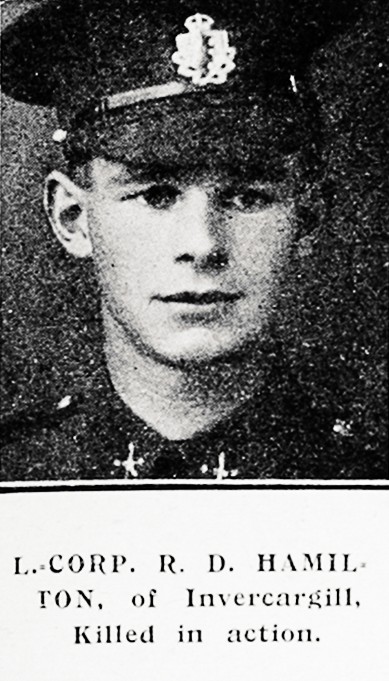L/Cpl
Robert Dane Hamilton
Informationen zu Geburt
|
Geburtsdatum: 06/05/1897 |
|
Geburtsort: Invercargill, Southland, New Zealand |
Allgemeine Informationen
|
Beruf: Textilfachverkäufer |
Informationen zum Armeedienst
|
Land: New Zealand |
|
Truppe: New Zealand Expeditionary Force |
|
Rang: Lance Corporal |
|
Dienstnummer: 56927 |
|
Einberufung datum: 11/05/1917 |
|
Einberufung ort: Dunedin, Otago, New Zealand |
|
Einheiten: — Otago Regiment, 1st Bn. (Letzte bekannte Einheit) |
Informationen zu Tod
|
Sterbedatum: 16/02/1918 |
|
Sterbeort: Polygon Wood, Zonnebeke, Belgien |
|
Todesursache: Im Kampf gefallen |
|
Alter: 20 |
Begräbnisplatz
|
Buttes New British Cemetery, Polygon Wood Grabstelle: I Reihe: B Grab: 18 |
Auszeichnungen und Orden 2
|
British War Medal Medaille |
|
Victory Medal Medaille |
Punkte von Interesse 3
| #1 | Geburtsort | ||
| #2 | Einberufung ort | ||
| #3 | Ort des Todes (ungefähr) |
Meine Geschichte
Robert Hamilton was born on 6 May 1897 in Invercargill, New Zealand, the son of William and Alice Hamilton. He was a drapers assistant with the Drapery Supply Association in Dunedin when he enlisted on 11 May 1917, service number 56927. After training at Trentham and Featherston camps he embarked with the 28th Reinforcement on 26 July 1917, from Wellington on the troopship Ulimaroa.
There was more training at Sling Camp (England) and Etaples (France) before he was posted to 1st Battalion, Otago Infantry Regiment on 11 November 1917.
After the Third Battle of Ypres closed in November 1917 the New Zealand Division, part of II Anzac Corps, took over a sector on the Ypres Salient. II Anzac frontage ran from Tiber pillboxes (1000m south of Passchendaele) to the Reutalbeek (stream) to the south – a distance of about 8000m. It covered the Polygon Wood area. The country was devastated, waterlogged and covered with the debris of war.
The New Zealand Division was heavily engaged in building defensive lines in this sector. An attempt to strengthen the right of the sector by capturing Polderhoek Spur and its ruined chateaux was made on 3 December, without success and with heavy losses.
After a brief period in camp behind the lines the 1st Otago Battalion moved back to the Polygon Wood sector on 8 February 1918. While in support, the battalion provided carrying parties and erected wire entanglements. The Battalion went into the front line in mid-February and it was during this period that Robert Hamilton was killed on 16 February. The opposing German forces generally held higher ground and movement in the New Zealand lines was often observed and shelled or machine-gunned.
He was buried in a cemetery close to his final burial place in Buttes New British Cemetery, Plot I, Row B, Grave 18. Two other soldiers of 1st Otago Battalion killed on 16 February were buried likewise.
There was more training at Sling Camp (England) and Etaples (France) before he was posted to 1st Battalion, Otago Infantry Regiment on 11 November 1917.
After the Third Battle of Ypres closed in November 1917 the New Zealand Division, part of II Anzac Corps, took over a sector on the Ypres Salient. II Anzac frontage ran from Tiber pillboxes (1000m south of Passchendaele) to the Reutalbeek (stream) to the south – a distance of about 8000m. It covered the Polygon Wood area. The country was devastated, waterlogged and covered with the debris of war.
The New Zealand Division was heavily engaged in building defensive lines in this sector. An attempt to strengthen the right of the sector by capturing Polderhoek Spur and its ruined chateaux was made on 3 December, without success and with heavy losses.
After a brief period in camp behind the lines the 1st Otago Battalion moved back to the Polygon Wood sector on 8 February 1918. While in support, the battalion provided carrying parties and erected wire entanglements. The Battalion went into the front line in mid-February and it was during this period that Robert Hamilton was killed on 16 February. The opposing German forces generally held higher ground and movement in the New Zealand lines was often observed and shelled or machine-gunned.
He was buried in a cemetery close to his final burial place in Buttes New British Cemetery, Plot I, Row B, Grave 18. Two other soldiers of 1st Otago Battalion killed on 16 February were buried likewise.
Quellen 1
|
Byrne AE., Official history of the Otago Regiment, NZEF in the Great War 1914-1918, (Dunedin, J. Wilkie & Co, 1921), pg. 266-68. Verwendete Quellen |
Weitere Informationen 5
|
Commonwealth War Graves Commission Database https://www.cwgc.org/find-records/find-war-dead/casualty-details/480262 |
|
Namenlijst (In Flanders Fields Museum) https://namenlijst.org/publicsearch/#/person/_id=dc0736ae-18e7-4be2-8039-2a65a9eaab44 |
|
Lives of the First World War (Imperial War Museum) https://livesofthefirstworldwar.iwm.org.uk/lifestory/7175731 |
|
The NZEF Project (UNSW Canberra) https://nzef.adfa.edu.au/showPerson?pid=104356 |
|
Online Cenotaph (Auckland Museum) https://www.aucklandmuseum.com/war-memorial/online-cenotaph/record/C6217 |
